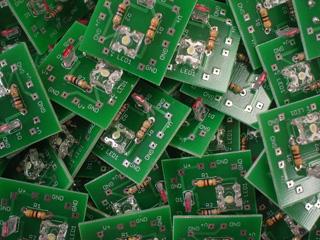Andrew Doro
Rory Nugent
Electronic Copy (Infrared Detector Cloud)
An uncontrolled, three-dimensional screen revealing an invisible infrared aura and technologies potential to mimic and enhance natural phenomenon; in this case, the light of a single tea candle.

Classes
Project Development Studio (Danny),The Softness of Things: Technology in Space and Form
Project Development Studio (Danny),The Softness of Things: Technology in Space and Form
Electronic Copy (Infrared Detector Cloud) is a light installation consisting of hundreds of custom-designed small infrared detecting circuits. In each detector, a warm white LED glows corresponding to the detected amount of infrared light. A small tea candle is placed in the center of the infrared detectors, providing a source of infrared light. The flickering of the flame is mirrored in each of the infrared detectors, creating an organic three-dimensional animation far more compelling than anything which could be programmed. The infrared detectors could be understood as an uncontrolled screen, responding to light phenomenon existing just beyond our senses. Other sources which provide infrared and affect the detectors are sunlight, fire, incandescent lights, remote controls, and some cameras which use infrared for automatic night focusing. The installation has applications as an architectural element to provide information about the surrounding environment.
Background
Although there has been some study by designers and architects, Hertzian space is still a largely unexplored field.
Some artists who have written or created work in this field:
Dunne & Raby, authors of Hertzian Tales.
Usman Haque.
Christina Kubisch.
informationlab, creators of cellphonedisco.
Carsten Nicolai.
Audience
Artists, architects, technologists, kids, anyone who likes art and design.
User Scenario
Visitors enter a darkened room, and encounter a cloud of flickering LEDs. At the center of the LEDs is a single small candle, surrounded by an IR-transparent, visible-opaque material. The visitors begin to realize that the LEDs are mimicking the flickering of the candle flame. They may also realize that the light installation will respond to any source of infrared light.
Implementation
The installation is composed of hundred of identical analog printed circuits suspended from the ceiling. Each small circuit consists of an infrared detector and high flux warm white LED. The more infrared light is detected, the brighter the LED will glow. At the center is a single tea candle surrounded by an IR-transparent, visible-opaque material. This allows the source of the infrared to be hidden from the viewer. There is no micro-controller, so the correspondence is immediate.
Conclusion
We learned a lot about infrared light, as well as how to get printed circuit boards made.
Background
Although there has been some study by designers and architects, Hertzian space is still a largely unexplored field.
Some artists who have written or created work in this field:
Dunne & Raby, authors of Hertzian Tales.
Usman Haque.
Christina Kubisch.
informationlab, creators of cellphonedisco.
Carsten Nicolai.
Audience
Artists, architects, technologists, kids, anyone who likes art and design.
User Scenario
Visitors enter a darkened room, and encounter a cloud of flickering LEDs. At the center of the LEDs is a single small candle, surrounded by an IR-transparent, visible-opaque material. The visitors begin to realize that the LEDs are mimicking the flickering of the candle flame. They may also realize that the light installation will respond to any source of infrared light.
Implementation
The installation is composed of hundred of identical analog printed circuits suspended from the ceiling. Each small circuit consists of an infrared detector and high flux warm white LED. The more infrared light is detected, the brighter the LED will glow. At the center is a single tea candle surrounded by an IR-transparent, visible-opaque material. This allows the source of the infrared to be hidden from the viewer. There is no micro-controller, so the correspondence is immediate.
Conclusion
We learned a lot about infrared light, as well as how to get printed circuit boards made.
